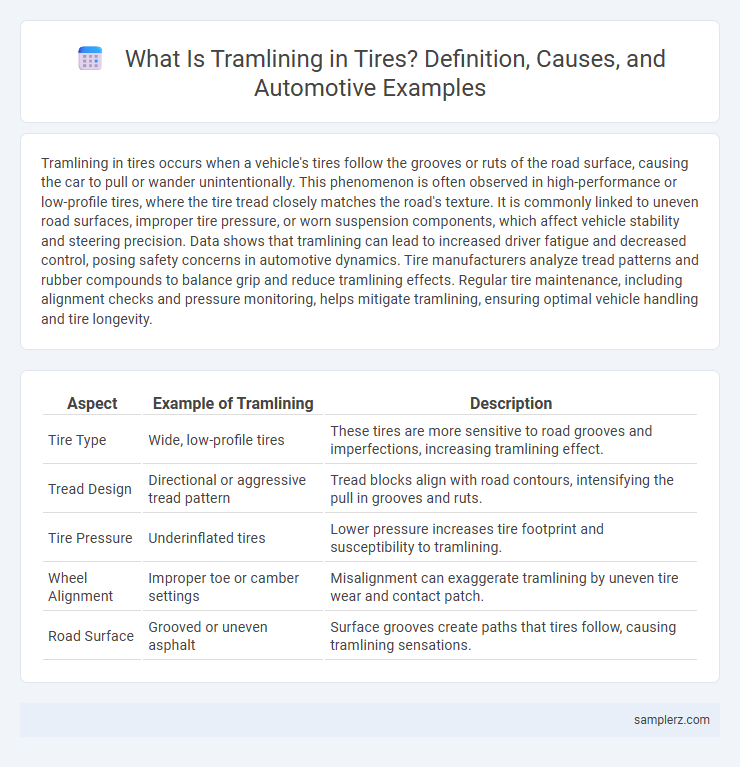Tramlining in tires occurs when a vehicle's tires follow the grooves or ruts of the road surface, causing the car to pull or wander unintentionally. This phenomenon is often observed in high-performance or low-profile tires, where the tire tread closely matches the road's texture. It is commonly linked to uneven road surfaces, improper tire pressure, or worn suspension components, which affect vehicle stability and steering precision. Data shows that tramlining can lead to increased driver fatigue and decreased control, posing safety concerns in automotive dynamics. Tire manufacturers analyze tread patterns and rubber compounds to balance grip and reduce tramlining effects. Regular tire maintenance, including alignment checks and pressure monitoring, helps mitigate tramlining, ensuring optimal vehicle handling and tire longevity.
Table of Comparison
| Aspect | Example of Tramlining | Description |
|---|---|---|
| Tire Type | Wide, low-profile tires | These tires are more sensitive to road grooves and imperfections, increasing tramlining effect. |
| Tread Design | Directional or aggressive tread pattern | Tread blocks align with road contours, intensifying the pull in grooves and ruts. |
| Tire Pressure | Underinflated tires | Lower pressure increases tire footprint and susceptibility to tramlining. |
| Wheel Alignment | Improper toe or camber settings | Misalignment can exaggerate tramlining by uneven tire wear and contact patch. |
| Road Surface | Grooved or uneven asphalt | Surface grooves create paths that tires follow, causing tramlining sensations. |
Understanding Tramlining: Definition and Causes
Tramlining in tires refers to the phenomenon where a vehicle's tires follow the grooves and ruts in the road surface, causing noticeable steering pull or wander. This is often caused by tire design factors such as aggressive tread patterns, wide and low-profile tires, or improper tire pressure. Road conditions like uneven pavement and wheel alignment issues also contribute significantly to tramlining, affecting vehicle stability and driver control.
Common Scenarios Where Tramlining Occurs
Tramlining commonly occurs on highways with pronounced grooves or uneven pavement, where tires follow road imperfections like train tracks. It also appears when using wide, low-profile tires on vehicles with stiff suspension, amplifying sensitivity to surface irregularities. Drivers may notice tramlining during high-speed cornering or in rainy conditions when water channels influence tire path stability.
How Tire Design Influences Tramlining
Tire design significantly influences tramlining by affecting how the tire interacts with road surface irregularities and grooves. Features such as tread pattern, tire width, and sidewall stiffness determine the tire's ability to maintain directional stability and resist pulling into road ruts. High-performance tires with asymmetric tread patterns and reinforced sidewalls reduce tramlining by providing better grip and improved road contact pressure distribution.
Real-World Examples of Tramlining in Modern Vehicles
Tramlining manifests in modern vehicles like the 2023 Ford F-150 and Tesla Model Y when steering feels overly sensitive on grooved highways, causing tires to follow road imperfections. Real-world reports highlight how high-performance tires, such as Michelin Pilot Sport 4S, exacerbate tramlining tendencies due to their aggressive tread patterns. Manufacturers often recommend tire rotation and pressure adjustments to mitigate these effects and enhance driving stability.
Impact of Worn Tires on Tramlining Behavior
Worn tires significantly increase tramlining behavior, causing the vehicle to follow road grooves or ruts more aggressively and reducing steering precision. Tread wear decreases tire grip and disrupts the tire's ability to maintain consistent contact with the road surface, exacerbating these directional stability issues. This leads to increased driver fatigue and compromised handling, especially at higher speeds or on uneven pavement.
Performance Tires vs. Regular Tires: Tramlining Differences
Performance tires exhibit more pronounced tramlining effects compared to regular tires due to their stiffer sidewalls and asymmetric tread patterns, which enhance road feel but also increase sensitivity to road surface irregularities. Regular tires typically have softer sidewalls and more uniform tread designs, resulting in less noticeable tramlining and a smoother, more forgiving ride. Drivers of performance tires may experience stronger steering pull and vibration when encountering grooves or ruts, highlighting the trade-off between high grip and ride comfort.
Road Surface Conditions That Exacerbate Tramlining
Uneven road surfaces with pronounced grooves and ruts significantly exacerbate tramlining by causing tires to follow these irregularities, reducing vehicle stability. High-friction asphalt combined with inconsistent textures intensifies tire grip variations, further influencing tramlining effects. Poorly maintained roads with gravel patches or potholes also increase the likelihood of tire wandering and directional instability.
Driver Experiences: Recognizing Tramlining Symptoms
Tramlining in tires manifests through noticeable steering wheel vibrations and a persistent pulling sensation, particularly when driving on grooved or uneven road surfaces. Drivers often experience reduced vehicle stability and increased effort to maintain a straight path, highlighting uneven tire wear or improper alignment as underlying causes. Early recognition of these symptoms allows timely tire inspection and alignment correction, enhancing safety and driving comfort.
Preventative Measures to Reduce Tramlining
Regularly maintaining proper tire pressure and performing wheel alignments help reduce tramlining by ensuring optimal tire contact with the road surface. Using tires with stiffer sidewalls designed for high-speed stability can minimize the steering sensitivity that causes tramlining. Rotating tires at recommended intervals promotes even wear, which further decreases the likelihood of tramlining effects.
When to Seek Professional Help for Severe Tramlining
Severe tramlining in tires, characterized by persistent steering pull and increased vibration, indicates potential alignment or suspension issues requiring professional inspection. When tire wear becomes uneven or handling worsens despite proper tire maintenance, it's crucial to visit an automotive specialist for precise wheel alignment and suspension diagnostics. Addressing these issues early prevents compromised vehicle safety and costly repairs.

example of tramlining in tire Infographic
 samplerz.com
samplerz.com